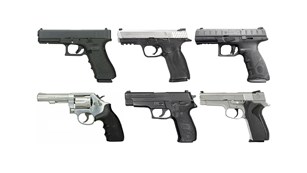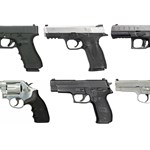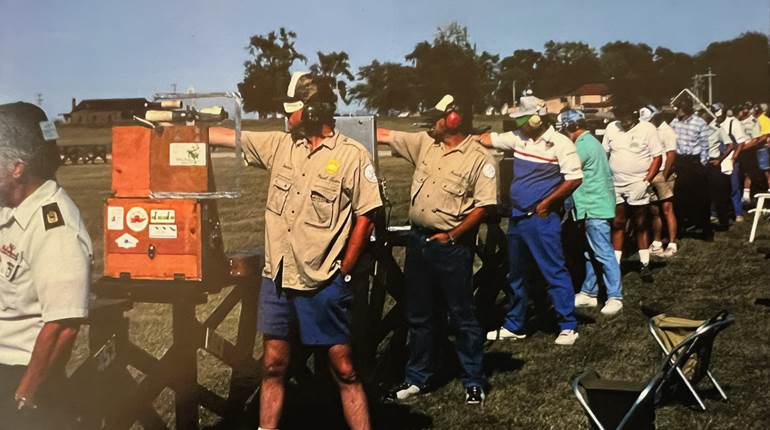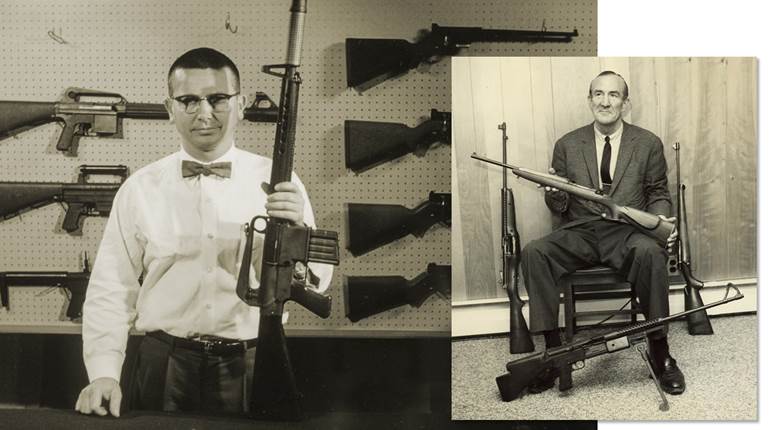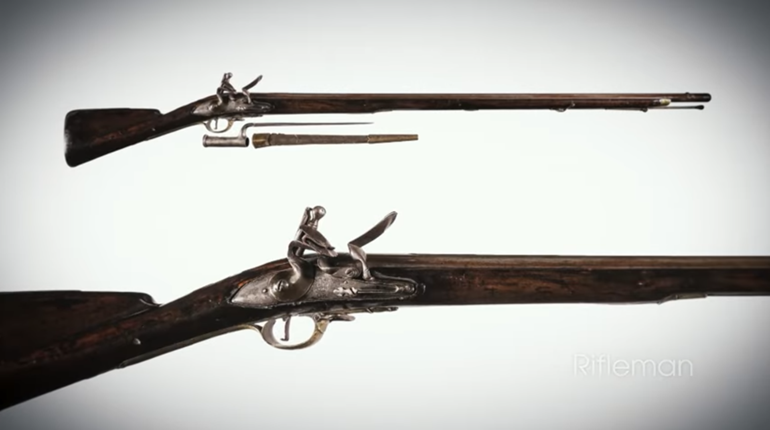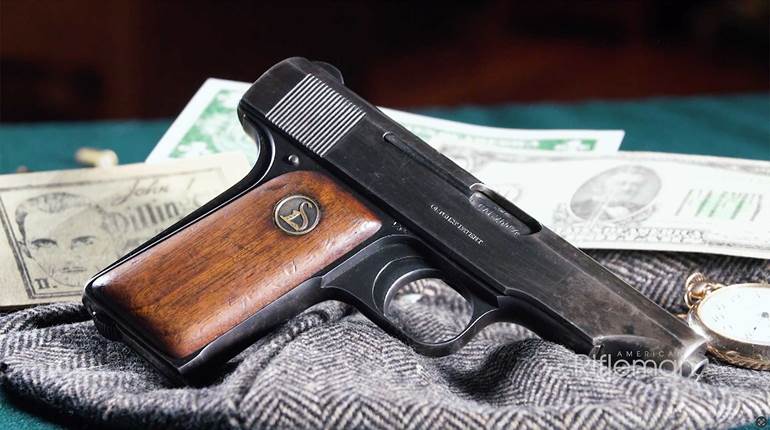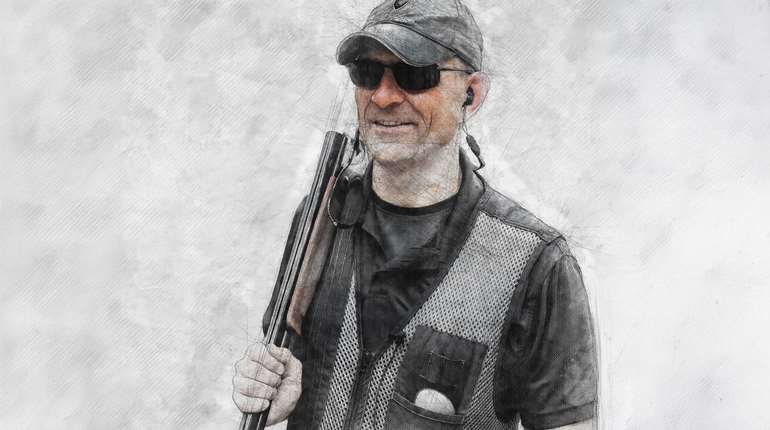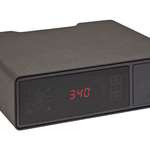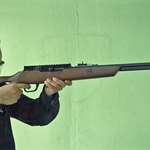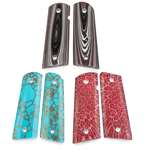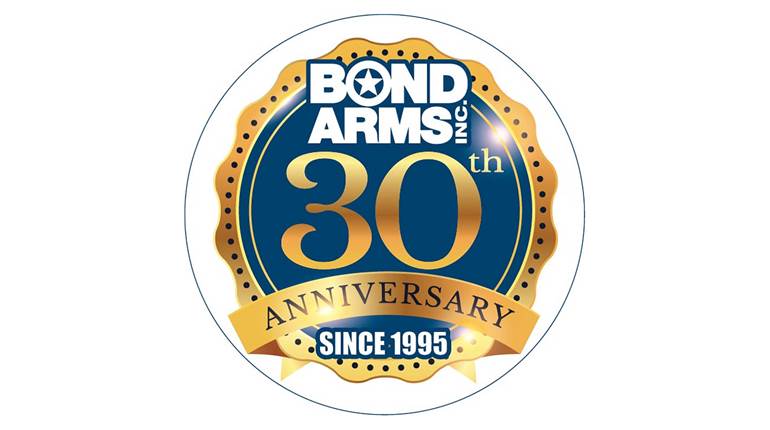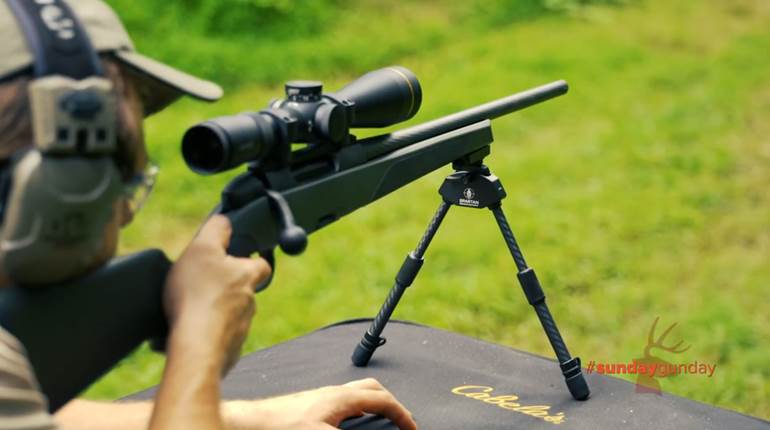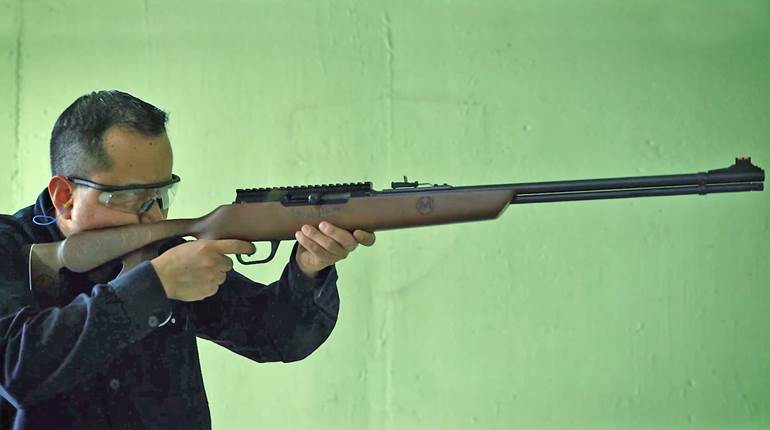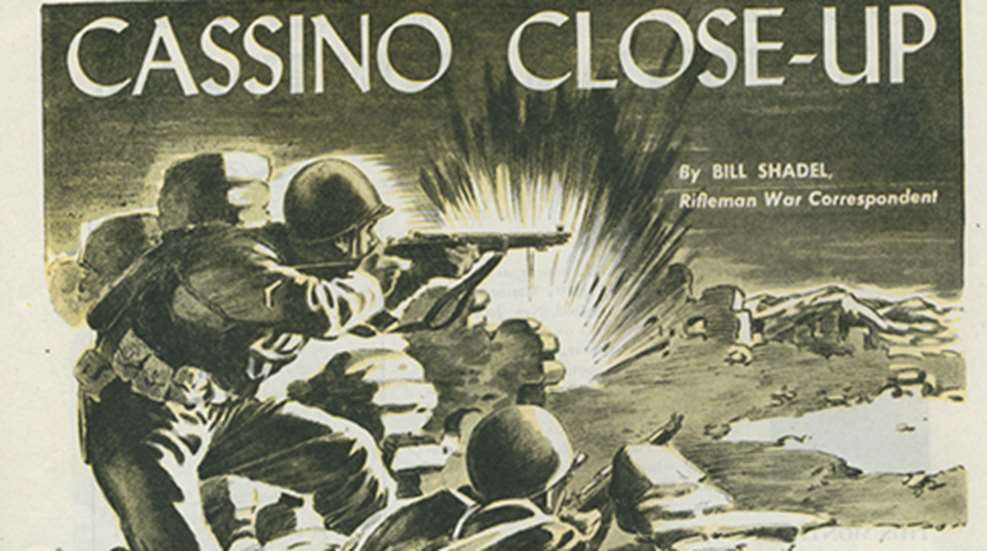
By Bill Shadel, Rifleman War Correspondent
Here is a clear, eye-witness, unvarnished account of the bitter stalemate at Cassino, written from a rifleman's viewpoint; the most illuminating article so far published in answer to questions current here at home. The "soft underbelly" looks awfully tough in this close-up-but so do the men who are attacking it!
With the Fifth Army in Italy, March 13-Cassino is a hard nut to crack. It is one of the first cities of size, so far encountered in the Italian campaign, which the Germans had time to prepare carefully and scientifically as one of the cornerstones of the Gustav Line.
Nestled against a mountain range, fortified throughout with pillboxes, backed up by artillery with the best possible observation, the city is confined to narrow elongated limits by the oft-flooded Rapido River which separates the valley of no-man's-land from our approach through the hills on the east.
Immediately overlooking the city on the west is the "to-bomb-or-not-to-bomb" Abbey, bombed finally but still sheltering plenty of Boche firepower. Other heights equally formidable stretch out to the north, providing an over-all cover for the intricate defenses of the city.
The foothold gained in Cassino, therefore, represents an attack of large proportions by three infantry regiments, backed up by Corps artillery, plus desperate street fighting; an infantry job, being handled by one of our finest infantry divisions-the 34th. House-to-house fighting here is the toughest yet encountered by any American outfit in this campaign.
Three of our regiments fronted Cassino across the flat on the east side of the Rapido. One 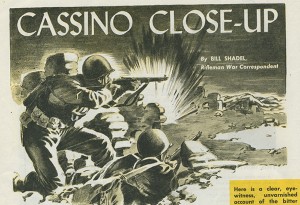 example of the lengths to which the Boche as gone in preparing to defend Cassino is the fact that the river itself has been diverted from its course, turning the approaches into swamps. One of our infantry regiments was in the sector opposite the city. A second regiment was opposite the northern limits and the barracks area; and a third regiment was held in reserve. With the first regiment demonstrating in front, the second attempted a crossing just north of the city. They got across, but immediately ran into mine fields and such fierce resistance that they were forced to withdraw.
example of the lengths to which the Boche as gone in preparing to defend Cassino is the fact that the river itself has been diverted from its course, turning the approaches into swamps. One of our infantry regiments was in the sector opposite the city. A second regiment was opposite the northern limits and the barracks area; and a third regiment was held in reserve. With the first regiment demonstrating in front, the second attempted a crossing just north of the city. They got across, but immediately ran into mine fields and such fierce resistance that they were forced to withdraw.
It thus became evident that the entry would have to be made by way of the barracks area from the north. This was necessarily a narrow approach, bounded on the left by the river and on the immediate right by the cliffs and fortified hills 324, 225, and 175. It, like the other attempts, was still predicated on a firmly established river crossing.
The third regiment was called up to make the all-important dent in the line. By means of the finest possible co-operation between infantry, engineers, and tanks, this regiment gained a foothold across the river, north of the barracks area, and swung north toward the little town of Cairo, in the foothills some three miles distant. The first regiment then swung out in the rear of the second over the bridged Rapido and on up into the higher ground ahead and to the left, toward the Abbey.
From its position across the Rapido, I Company of one battalion was pulled out of the second regiment to make the attempt at the barracks. Under Captain W.D. Fraizer, it moved north on the afternoon of February 1, turned to make its crossing some 600 yards to the north of the barracks and, by six o'clock of that afternoon, was ready to move south down the road to the barracks. By early morning it had destroyed a self-propelled gun and cleaned up the small-arms fire within the barracks. L company, under Lieutenant D.F. Neal, was then brought up over the same route and, by seven-thirty o'clock of the second, both companies were ready to move on Cassino itself.
L Company was assigned the job of clearing the high ground immediately above the narrow route this established. I Company, with three tanks, was to clear the road and narrow flat. By eleven o'clock that morning, L Company had gone through Hills 324 and 225, and held part of Hill 175, the anchor of a hastily erected German east-west line fringing the first few houses of the city's northern limits. I Company was held up before this line and took cover in a quarry.
While L Company continued its attack against the German-held part of Hill 175, tanks were sent against the east-west line but encountered direct fire from SP guns within the town and were knocked out. German snipers were still effective, firing from the higher ground, including Hill 225; so K Company was brought up from reserve and sent over the slopes above the area already covered by L Company.
By daylight of the third, K had helped L Company clear Hill 175, necessary prelude to I Company's breaching of the east-west line. On the afternoon of the third, supported by artillery and tank destroyers, I Company, with the help of one platoon from K, broke through and into the first few houses of northern Cassino. On the night of the fourth, A Company of one battalion was brought up to relieve K Company on the hills, and the rest of K Company was pulled into town. A heavy weapons company was brought up; mortars were placed at the south edge of the barracks; heavy machine guns were mounted between Hills 225 and 175. In the city, it was now L Company on the left, I Company in the center, and K Company on the right.
An interesting sidelight in connection with Hill 175 was its service as an OP for the direction of 240 mm. fire on the German-held part of the city. One officer said that this was the first time he had ever directed fire from an OP that was in front of and in a direct line between the gun and the objective.
With I Company in one of the few captured houses was Pvt. Fred Ratliffe, of Pontiac, Michigan; a lad who had done a lot of hunting before army days, had qualified with both the M1 and the carbine. Pvt. Ratliffe found the carbine especially useful in snap shooting from windows. He says, "We spent the first night barricading, building up shelters on the first floor out of the rubble. We could hear Jerry moving in the houses just across the street. There were just five of us and we were pretty scared."
The second day there, Ratliffe spotted a Heinie sneaking along a wall. He could just see the German's helmet above the wall and waited until Jerry reached an opening. "I got off one quick shot and know I hit him, 'cause a couple other Jerries reached out to pull him back, and I got one of them, too." The boys felt better after that and kept up a constant watch.
Another time, when some of the other boys of I Company were trying to move across the street, Ratliffe got action with the tommy gun. "This Jerry was running from one house to another and I sprayed him. He lay there all day, but was gone the next morning."
Lieutenant Higgins, who took over command of I Company when Captain Fraizer was 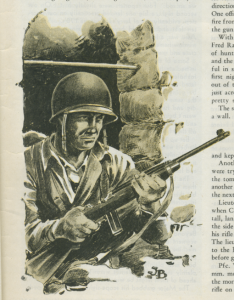 wounded, had more to say about this tall, lanky, blonde youngster. He said Ratliffe would stand at the side of the window until he saw a target, then would snap his rifle to his shoulder, fire, and duck back into the shadows. The lieutenant also told how, when Bazookas were brought up to the house, Ratliffe, although he and never fired a Bazooka before got off some shots at a house that contained machine guns.
wounded, had more to say about this tall, lanky, blonde youngster. He said Ratliffe would stand at the side of the window until he saw a target, then would snap his rifle to his shoulder, fire, and duck back into the shadows. The lieutenant also told how, when Bazookas were brought up to the house, Ratliffe, although he and never fired a Bazooka before got off some shots at a house that contained machine guns.
Pfc. Wayne C. Bryan, of Rahway, New Jersey, was on a 60 mm. mortar until more help was needed in Cassino. He left the mortar, started out with a .45, picked up a German Mauser rifle on the way and, while he was on a lookout of Hill 175, got a shot at a Jerry, dropping him at about 200 yards. Bryan later tried several shots with a carbine at Jerries being chased up the draw by K Company, but was outranged at from 250 to 400 yards.
Joining I Company in town, Bryan used an M1 from the windows. "When our boys started cleaning out the square and the Jerries started running back, I could lean right out the window and fire. I got quite a few shots and know I hit two. One of them almost reached the far side of the square but I dropped him. That was at about 200 yards. Three of us in that house gave the boys as much covering fire as we could. The M1 is lots better than the carbine for that kind of work."
Sgt. S. Bannon, of Bakersfield, California, was with K Company in Cassino. He was a confirmed believer in the BAR and had no reason to change his mind in the midst of the street fighting there. Out of the rubble from the broken-down walls he made a bunker for protection against more shelling. He stuck the muzzle of his BAR through an opening in the wall made by one of the German bazookas. Once he put a burst into a doorway across the street and saw a shadow go down. Again, a German in a house not more than fifty feet away started firing rifle grenades from a window. The German exposed himself enough to give Bannon a shot, and that was the end of the rifle grenades.
One of the costly assault jobs was against an old schoolhouse. Three even costlier ones were against the jail. Not only was the jail heavily fortified but all avenues leading to it were covered by machine guns. In these assaults we learned the costly meaning of leadership, the depletion of noncoms and commissioned officers who must be out in front for every attack. In the first strike at the jail, one officer, new to his company, led a small group of seventeen men, got in one room with three of his men before the rest were cut off by machine gun fire. The next time he tried leading, he was killed.
In the second attempt at the jail, Lieutenant X led twelve men to the left while another lieutenant pointed fifteen to the right. Those on the left got four men across the road before the others were cut off by machine guns. Those on the right worked along a wall but could go no farther because of enfiladed fire. Two days later a night attack put five men in one room of the jail. Still later, a part of one battalion took over the jail and a few adjoining houses.
Sgt. E. Drewis, of Tripoli, Iowa, a machine gunner with L Company, was one of the heroes of Cassino. Quiet, shy, none too willing to go into the details of his experiences, we heard a modest account from him and later learned from Lieutenant Neal that he and another sergeant, J. Gaizzetti, tackled a machine gun nest in some bunkers set up in an open space across a drainage ditch which covered the approach to the jail. Sneaking along the ditch, then rushing to within hand grenade distance, they threw grenades and followed up with rifle fire. After cleaning up that job, these two got into a broken-down house, found two half-tracks parked in the court, threw grenades into them, set them afire, and then rejoined their company.
Sgt. Drewis was in a hot spot while giving supporting fire to those of his company who were making the assaults on the jail. In the ten days his machine gun faced the jail from across the street, the house he was in had twenty-five direct hits. He had made a pillbox for himself, however, out of timber and rubble and the crumbling walls only piled up for his protection. Pfc. George Rashbaum, of Brooklyn, N.Y., had never fired a gun before he got into the army. He had plenty of chances in Cassino, however! His first morning in town, his sergeant led him and five others in an attack on a house. They sneaked along a wall, dashed across the street and threw grenades into the house. Four of them got inside. The sergeant was the first man in and turned his tommy gun on one Jerry that showed fight. One other was taken prisoner, but then they found themselves cut off. Unwilling to give up their position, they stayed there two days without supplies. When they were finally pulled out with their prisoner, they were then put into the attack of L Company on the jail.
Rashbaum started out with some fifteen others to attack from the left. They ran into a withering fire, hit the irrigation ditch alongside, then ducked back to the house from where they had started. Soon after, a direct hit on a central beam overhead collapsed the entire second floor, burying ten of the group.
This is a sample of the first days in Cassino. From interviews with officers and men, one gets an idea of the fighting, of the endless days of waiting and watching, of the frequent desperate rushes to take more houses. Everyone talks about the clever defenses of the Boche. All of them spoke of the devilish booby trap installations. One engineer officer who makes a specialty of the things told us he had found more than fifty different varieties.
The superhuman effort to increase the hold and to open up a greater area as a base for more troops to continue the job, was necessarily placed on the shoulders of a comparatively few men. In view of the circumstances, they accomplished more than could be expected. With more men and fresh men available, additional holdings might have been made, but at a price. The odds were great. An overtaxed, tired, depleted division was spread out over the hills. Because of sheer exhaustion from more than fifty days in contact with the enemy they were simply unable to furnish that extra punch to carry the heights. A clean up of the overhanging mountain fortifications, and of the Abbey in particular, was necessary. The bombing of the Abbey was delayed, for reasons known to all. Weather conditions barred the daily support of the Air Force and at the same time flooded the valley. A stalemate of a few weeks was inevitable.
If there is any criticism to be directed at the Cassino effort, it is only the old story of "too little, too late." Had fresh troops been available, the Hun might have been driven out. Fresh troops could have taken advantage of the shock set up throughout the German positions by the veterans of the 34th Division. Theirs was an heroic effort.
By Cassino is a testing ground on which lessons are being learned; lessons in tactics, lessons in the uses and application of weapons. Major W.C. Chapman, West Point, class of '39, pointed out two lessons in tactics when he said, "Take advantage of shock. Once you've hit a spot hard with grenades, or with artillery, or tanks, get your men in there now! Get in while the enemy is dazed, cowering in the corner, with all the fight knocked out of him. Five minutes later and he'll have pulled himself together and be ready to fight you again. Instill more discipline; the kind of discipline that will enable officers and noncoms to send men forward, without having to lead them. Sure, officers must have the guts to point the attack, must prove that fact to themselves and to the men. But they can't be out in front of every squad, every half-dozen men. When you're on the move and there's a new objective every few minutes, if officers and noncoms lead every rush you'll very soon find yourself with no leadership left, and the job only half done!"
Lessons in weapons are many and varied. The Germans here stressed fire power. Our troops met heavy concentrations of light machine guns and machine pistols. The psychological effect of that is noticeable in the talk of officers and men alike. But they are using snipers now, in increasing numbers and with increasing effect. And our snipers, and the aimed fire of our troops, put the crimp in plenty of German fire power.
Only a few Gewehr 41's (the German semi-automatic rifle) have shown up here. They are not highly regarded by our men. The German 34 and 42 machine guns, however, are plentiful and are considered excellent weapons. The Germans haven't matched our .50's, but some of our men are talking of a German 20 mm. heavy machine gun firing HE and AP ammunition.
Opinion seems to weigh heavily against the sniper equipment we are using here. The sniper gun is the '03A4, with the 330 Weaver scope. A few of the snipers who respect the delicacy with which a scope should be handled, get along all right with it. The larger number, however, complain that the scopes fog up under weather conditions encountered here, and that ordinary handling under battle conditions results in scope damage. Some officers consider the scope mount satisfactory, but criticize the scope itself. Others object to the necessity of loading one cartridge at a time, due to the fact that the scope prevents clip loading. They say targets often demand quickly repeated shots. The commonest physical damage to scopes is breakage of cross hairs. Post reticules have stood up better under battle conditions.
Favorite item of battlefield salvage is Jerry's "oil and thong" gun-cleaning kit; a metal container resembling a Prince Albert tobacco can, containing oil, patches, brushes, and a pull-through chain. Care of weapons is an obsession with men in the line, and is essential where guns are constantly exposed to mud, rain, snow, or rock dust from the rubble of shelled buildings. A man wants the weapon he depends upon to save his life to be ready to function! Jerry's "Prince Albert can" can be, and is, carried everywhere. It provides an adequate supply of oil, and it's pull-through chain is especially popular.
I have heard considerable criticism of the carbine; criticism arising mainly from misconception of its mission. It was most useful in the street fighting in Cassino, where snap shooting out of windows at fast-moving targets at close range was common. But the carbine is definitely a short-range weapon; and too many men waste ammunition and expose their position by firing the carbine at ranges at which it is ineffective. The M1, on the other hand, is popular with everyone. It is voted the ideal weapon for covering fire, aided, of course, by the machine guns.
The "bazooka" is gaining popularity. Most frequent question asked about this, as about all weapons, is, "Why weren't we given enough ammunition in training to enable us to learn to shoot well?" In Cassino, the bazooka proved invaluable in breeching the walls of houses to be stormed. Doors and windows were sure to be covered by established enemy guns, but the bazooka would provide a new entrance. Officers and men agree that it was only Jerry's respect for our bazookas, which he knew were in American-held houses, that kept him from sending more tanks into the town. The only general criticism of the weapon was its susceptibility to damage in carrying or due to weather conditions. The rifle grenade ranks with the bazooka in the minds of our street and house-t0-house fighters in Cassino.
Diversity of weapons, coupled with the ability of all men to use all weapons-that is the lesson learned here in Cassino. Have weapons to meet varying conditions; teach all men to use all weapons; then furnish plenty of the right kind of weapons.
In battle, mortar men become riflemen; grenadiers, BAR men; machine gunners, bazooka shooters, or what have you. Men find themselves forced to fight with all of their own weapons, and with captured weapons. A man may start out with an M1, lose it, find a carbine, lose that, find a German Gewehr, lose that and pick up a bazooka, all in a day. Adaptability of all men to the use of all weapons is the only adequate answer.






